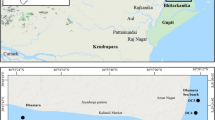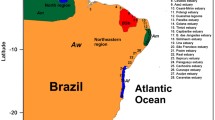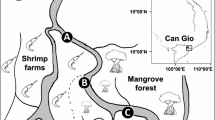Abstract
Quantifications of CO2 fluxes across the air–water interface of estuarine ecosystems are needed to understand regional carbon balances. In this study, we estimate the amount of carbon emitted from tropical estuaries of the State of Pernambuco, Brazil, using measurements of temperature, alkalinity, salinity and pH at stations located in the estuaries. The results showed that the average CO2 fluxes (+51 ± 32 mmol m−2 day−1) were mainly a product of the input of aloctone organic matter from urban centers with high population densities (~1,000 inhabitants.km−2) adjacent to the estuarine systems. This organic material increased the amount of aqueous CO2, which increased the pCO2 to 8,900 μatm. October, November and December had the highest monthly averages of the parameters associated with the carbonate system (HCO3 −, dissolved inorganic carbon, aqueous carbon dioxide, CO3 2−, total alkalinity, temperature and pH), whereas the averages in July correlated with the CO2 fluxes. Multivariate analysis revealed that estuarine areas near the most densely populated areas (Beberibe—9,000 inhabitants.km−2 and Paratibe—3,000 inhabitants.km−2) were positively correlated with high CO2 fluxes and high pCO2.








Similar content being viewed by others
References
Abril G, Frankignoulle M (2001) Nitrogen–alkalinity interactions in the highly polluted Scheldt basin (Belgium). Water Res 35:844–850. doi:10.1016/S0043-1354(00)00310-9
Abril G, Etcheber H, Borges AV, Frankignoulle M (2000) Excess atmospheric carbon dioxide transported by rivers into the Scheldt estuary. C R Acad Sci Ser II Sciences de la Terre et des planètes 330:762–768. doi:10.1016/S1251-8050(00)00231-7
APAC (2013) Precipitação do Estado de Pernmabuco (2012–2013). http://www.apac.pe.gov.br. Accessed 20 Aug 2013
Araujo M, Noriega C, Veleda D, Lefèvre N (2013) Nutrient input and co2 flux of a tropical coastal fluvial system with high population density in the Northeast region of Brazil. J Water Resour Prot 5:362–375. doi:10.4236/jwarp.2013.53A037
Borges AV (2005) Do we have enough pieces of the jigsaw to integrate CO2 fluxes in the coastal ocean? Estuaries 28:3–27. doi:10.1007/BF02732750
Borges AV, Delille B, Frankignoulle M (2005) Budgeting sinks and sources of CO2 in the coastal ocean: diversity of ecosystems counts. J Geophys Res 32:L14601. doi:10.1029/2005GL023053
Chen CT, Borges AV (2009) Reconciling opposing views on carbon cycling in the coastal ocean: continental shelves as sinks and near-shore ecosystems as sources of atmospheric CO2. Deep Sea Res Part II 56:578–590. doi:10.1016/j.dsr2.2009.01.001
Chen CT, Huang TH, Fu YH, Bai Y, He X (2012) Strong sources of CO2 in upper estuaries become sinks of CO2 in large river plumes. Curr Opin Environ Sustain 4:179–185. doi:10.1016/j.cosust.2012.02.003
Chen CT, Huang TH, Chen YC, Bai Y, He X, Kang Y (2013) Air–sea exchanges of CO2 in the world’s coastal seas. Biogeosciences 10:6509–6544. doi:10.5194/bg-10-6509-2013
Cloern J, Jassby AD (2012) Drivers of change in estuarine-coastal ecosystems: discoveries from four decades of study in San Francisco Bay. Rev Geophys 50(4):1–33. doi:10.1029/2012RG000397
Cole JJ, Prairie YT, Caraco NF, McDowell WH, Tranvik LJ, Striegl RG, Duarte CM, Kortelainen P, Downing J, Middelburg JJ, Melack J (2007) Plumbing the global carbon cycle: integrating the terrestrial carbon budget. Ecosystems 10(1):172–185. doi:10.1007/s10021-006-9013-8
CONAMA (National Council of the Environment) (2005) Determination CONAMA N°357, 17 March of 2005. http://www.mma.gov.br/port/conama. Accessed 15 Dec 2012
CPRH (2012) Monitoramento das bacias hidrográficas do Estado de Pernambuco (2012). http://www.cprh.pe.gov.br. Accessed 30 Jan 2013
Dickson AG (1990) Standard potential of the reaction: AgCl(s) + 1/2 H2(g) = Ag(s) + HCl(aq), and the standard acidity constant of the ion HSO4 − in synthetic seawater from 273.15 to 318.15 K. J Chem Thermodyn 22:113–127. doi:10.1016/0021-9614(90)90074-Z
Diego-McGlone MLS, Smith SV, Nicolas VF (2000) Stoichiometric Interpretations of C: N: P ratios in organic waste materials. Mar Pollut Bull 40:325–330. doi:10.1016/S0025-326X(99)00222-2
Frankignoulle M, Abril G, Borges A, Bourge I, Canon C, Delille B, Libert E, Théate JM (1998) Carbon dioxide emission from European estuaries. Science 282(5388):434–436. doi:10.1126/science.282.5388.434
Grasshoff K, Ehrardt M, Kremling K (1983) Methods of seawater analysis. Verlag Chemie, Miami
IBGE (2011) Population Census 2000. http://www.ibge.gov.br/home/estatistica/populacao/default_censo_2000.shtm. Accessed 15 Sept 2013
INMET (2013) Precipitação nos municípios do Estado de Pernambuco (1982–2013). http://www.inmet.gov.br. Accessed 20 Aug 2013
Laruelle GG, Dürr HH, Slomp CP, Borges AV (2010) Evaluation of sinks and sources of CO2 in the global coastal ocean using a spatially-explicit typology of estuaries and continental shelves. Geophys Res Lett 37:L15607. doi:10.1029/2010GL043691
Millero FJ, Graham TB, Huang F, Bustos-Serrano H, Pierrot D (2006) Dissociation constants of carbonic acid in seawater as a function of salinity and temperature. Mar Chem 100:80–94. doi:10.1016/j.marchem.2005.12.001
Mortatti J, Probst JL, Oliveira H, Bibian JP, Fernandes A (2006a) Fluxo de Carbono inorgânico dissolvido no Rio Piracicaba (São Paulo): partição e reações de equilíbrio do sistema carbonato. Geociências 25(4):429–436
Mortatti J, Probst JL, Oliveira H, Bibian JP, Lopes RA, Bonasi JA (2006b) Origem do Carbono Inorgânico Dissolvido no Rio Tietê (São Paulo): Reações de equilíbrio e variabilidade temporal. Geochim Bras 20(3):267–277
Neal C, House W, Jarvie H, Eatherall A (1998) The significance of dissolved carbon dioxide in major lowland rivers entering the North Sea. Sci Total Environ 210–211:187–203. doi:10.1016/S0048-9697(98)00012-6
NOAA (National Oceanic and Atmospheric Administration). Earth System Research Laboratory. Global Monitoring Division. http://www.esrl.noaa.gov/gmd/dv/site/. Accessed 01 Aug 2013
Noriega C, Araujo M (2009) Nitrogen and phosphorus loading in coastal watersheds in 652 northeastern Brazil. J Coast Res 56:871–875
Noriega C, Araujo M, Lefèvre N (2013) Spatial and temporal variability of the CO2 fluxes in a tropical, highly urbanized estuary. Estuaries 36:1054–1072. doi:10.1007/s12237-013-9608-1
Peel MC, Finlayson BL, Mcmahon TA (2007) Updated world map of the Köppen–Geiger climate classification. Hydrol Earth Syst Sci 11:1633–1644. doi:10.5194/hess-11-1633-2007
Raymond PA, Cole JJ (2001) Gas exchange in rivers and estuaries: choosing a gas transfer velocity. Estuaries 24(2):312–317. doi:10.2307/1352954
Robbins LL, Hansen ME, Kleypas JA, Meylan SC (2010) CO2calc: a user-friendly seawater carbon calculator for Windows, Max OS X, and iOS (iPhone): US Geological Survey Open-File Report 2010–1280. http://pubs.usgs.gov/of/2010/1280/
Rounds SA (2006) Alkalinity and acid neutralizing capacity (ver. 3.0): US Geological Survey techniques of water-resources investigations, book 9, chap. A6. sec. 6.6. http://pubs.water.usgs.gov/twri9A6/. Accessed 13 June 2012
Sarma VVSS, Vishnuvardham K, Rao GD, Prasad VR, Kumar BSK, Naidu SA, Kumar NA, Rao DB, Sridevi T, Krishna MS, Reddy NP, Sadhuram Y, Murty R (2012) Carbon dioxide emissions from Indian monsoonal estuaries. J Geophys Res 39:L03602. doi:10.1029/2011GL050709
Souza MFL, Gomes VR, Freitas SS, Andrade RCB, Knoppers BA (2009) Net ecosystem metabolism and nonconservative fluxes of organic matter in a tropical mangrove estuary, Piauí River (NE of Brazil). Estuaries 32:111–122. doi:10.1007/s12237-008-9104-1
Weiss RF (1974) Carbon dioxide in water and seawater: the solubility of a non-ideal gas. Mar Chem 2:203–215. doi:10.1016/0304-4203(74)90015-2
Weiss RF, Price BA (1980) Nitrous oxide solubility in water and seawater. Mar Chem 8:347–359. doi:10.1016/0304-4203(80)90024-9
Acknowledgments
We thank the Brazilian National Institute of Meteorology (INMET) for the database used in this study. This work was supported by the National Institute on Science and Technology in Tropical Marine Environments INCT-AmbTropic (CNPq/FAPESB Grants: 565054/2010-4 and 8936/2011). C. N. is grateful to the FACEPE (Foundation for Science and Technology of Pernambuco) for financial support through the Process No. BFP-0007-1.08/2012, which contributed to the development of the work.
Author information
Authors and Affiliations
Corresponding author
Additional information
Editor: Wolfgang Cramer.
Electronic supplementary material
Below is the link to the electronic supplementary material.
Rights and permissions
About this article
Cite this article
Noriega, C., Araujo, M., Lefèvre, N. et al. Spatial and temporal variability of CO2 fluxes in tropical estuarine systems near areas of high population density in Brazil. Reg Environ Change 15, 619–630 (2015). https://doi.org/10.1007/s10113-014-0671-3
Received:
Accepted:
Published:
Issue Date:
DOI: https://doi.org/10.1007/s10113-014-0671-3




